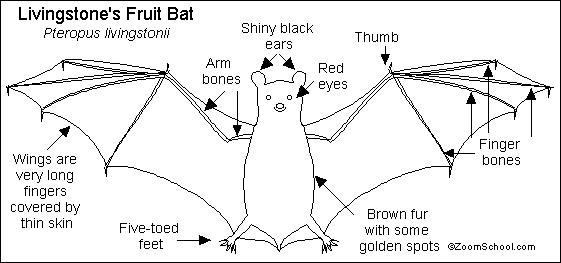
 |
| More on Bats | EnchantedLearning.com Fruit Bats Family Pteropodidae | Animal Printouts Label Me! Printouts |


Pollination and Seed Dispersal: As fruit bats fly from plant to plant getting food, they also pollinate the plants they visit. In addition, they disperse the plants' seeds as they eat. Many plants, including some avocados, dates, mangos, and peaches, are dependent on these bats for either pollination or seed dispersal.
Anatomy: Fruit bats are relatively large bats. Their wings are long fingers covered by thin skin, and the body is furry. Males and females look alike. Like all bats, they have weak legs and don't walk very well. Livingstone's Fruit Bat (Pteropus livingstonii, from Africa) is one of the largest fruit bats; it has a wingspan of up to 6 ft (1.8 m). The long-tongued fruit bat (Macroglossus minimus) is one of the smallest fruit bats; it has a wingspan of 5-6 inches (13-15 cm).
Senses and Diet: Fruit bats mostly eat fruit juice and flower nectar. They chew the fruit, then spit out the seeds, peel, and pulp. Fruit bats, like other Megachiropteran bats, use the sense of smell to find their food, fruit and/or nectar. Although they have large eyes and can see well, fruit bats do not use sight as their primary sense.
| Search the Enchanted Learning website for: |